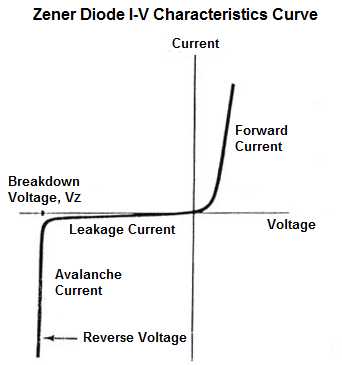Zener Diode I-V Characteristics Curve

Zener Diode Characteristics
This article will help to explain the characteristics which make up zener diodes, specifically how the voltage across a zener diode varies with the current flowing through it.
The I-V Characteristics Curve of a zener diode, shown below, is the curve which shows the current-voltage
relationship of a zener diode.

The zener diode goes through a number of different regions or stages, of which are explained below.
The right half side of the characteristics curve is the part in which the zener diode receives forward voltage, which is positive voltage across its anode to cathode terminals. The diode in this region is in forward biased. During this period, the current is small for a while until it spikes exponentially up once the voltage reaches a certain point, called the threshold voltage.
The left half side of the characteristics curve is the more important part, when considering zener diodes. This is the part in which the zener diode receives positive voltage across its cathode to anode terminals. The diode in this region is reverse biased. At first, when receiving reverse voltage, the current is very small. There is only a small current, called the leakage current, flowing through the diode. Once it hits the breakdown voltage, the current drastically increases. This current is the called the avalanche current, because it spikes so drastically. The breakdown voltage point is also important, not just because of the avalanche current, but more importantly because once the voltage of the zener diode has reached this point, it remains constant at this voltage, even though the current across it may increase largely. This makes the zener diode useful in applications such as voltage regulation.
The zener diode has the important characteristic in that once the voltage across a zener has reached this breakdown voltage, also called a zener diode's zener voltage, VZ, the voltage that a zener drops across itself will not continue to increase. For example, if a zener diode has a zener voltage of 5.1V, and the voltage feeding the diode is approximately 5.1V, the zener will drop the 5.1V across its terminals. Now if the voltage supplying it continues to increase, to say 12V, the zener diode will maintain its zener voltage, 5.1V, even though the voltage (and current) supplying it continues to increase.
This is the single most important characteristic of a zener diode, which as stated before, allows it
it to act as a voltage regulator in a circuit. The voltage that is dropped across a zener will not exceed its breakdown or zener voltage,
even if the voltage or current in the circuit
increases, which is what the I-V characteristics curve above depicts.
Related Resources
What is the Zener Voltage, VZ, of a Zener Diode?
What is the Resistance, RZ, of a Zener Diode?
What is the Current, IZM of a Zener Diode?
What is the Power Rating, PZM, of a Zener Diode?
How to Build a Zener Diode Voltage Regulator
